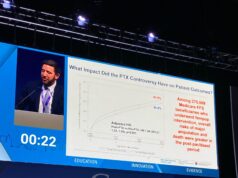The Journal of Vascular and Interventional Radiology (JVIR) —the monthly, peer-reviewed flagship publication of the Society of Interventional Radiology—earned an impact factor of 2.064, an increase from 1.805 in 2009, according to new data released in the 2010 Journal Citation Reports published by Thomson Reuters.
JVIR ranks higher than other prominent journals in the radiology, nuclear medicine and medical imaging category, such as CardioVascular and Interventional Radiology (CVIR). The impact factor is the measure of a journal’s significance based on the number of article citations compared to the total number of articles published. It is often used as a measure of the quality and influence of medical journals within scientific, professional and academic communities. JVIR published 275 articles in 2010, earning 5,900 citations among radiology, nuclear medicine and medical imaging journals and peripheral vascular disease journals.
“The Journal of Vascular and Interventional Radiology’s increased ranking reflects the journal’s unflagging commitment to quality and tradition of excellence, showing it as an essential resource for interventional radiologists, radiologists, cardiologists, vascular surgeons, neurosurgeons and other clinicians across the United States and the world who need current and reliable information on every aspect of vascular and interventional radiology,” said Ziv J Haskal, editor in chief, Journal of Vascular and Interventional Radiology (JVIR).
“JVIR is the highest ranked interventional radiology journal in the world. It continues to be the vigorous forum for the most novel and impactful, global, cutting-edge, basic science research, clinical reports and evidence-based medicine. JVIR science can truly provide patients with the best possible health care,” he added. “Always innovative, JVIR is providing rapid, tight reviewing and early decision—giving authors visibility for their research and readers increased access to more information through multiple new channels,” said Haskal.
The journal has further expanded the ways in which it delivers news of the specialty with the new JVIR podcast channel, providing short, hard-hitting interviews that provide insight into methodology, controversy and next directions for research, said Haskal. JVIR’s Web site has been redesigned and includes many new features, such as improved navigation; access to current articles, features and issues; and the most up-to-date information on research.












